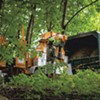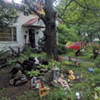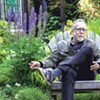Published April 28, 2004 at 1:09 p.m.
When I pulled into the driveway of my mom's South Burlington home last June, I couldn't help but notice the front lawn had been replaced by what looked like an art installation crossed with a vacant lot. Up to then, my mom's suburban yard hadn't looked much different from those of her neighbors -- a plot of grass framed by flowerbeds, tall spruce, and juniper and arbor vitae planted a decade ago by landscapers.
Now I was staring at a maze of ovoid plots, each a jumble of herbs and tiny trees and bushes adorned with meticulous labels. Driftwood logs outlined the plots, and one was topped by a sunbleached bone that looked like it had belonged to a steer. My sister put it more bluntly: "What's all that junk in the yard?"
"It's a forest garden," my mother said proudly. But instead of offering an explanation, she handed me a book on the subject by British author Robert Hart.
I decided to go out and have a look-see. Strolling among the "plots," I saw that some of the plants were humble: bunch berry, the dreaded creeping Charlie. Others had a tinge of the exotic: Siberian pea-shrub, bush cherry. Most of them looked like knee-high dry sticks, though the raspberry and gooseberry bushes are supposed to bear fruit. But "forest" garden?
"I would call it an urban woodland," said Craig Volpe, my mother's accomplice -- a young man with a laid-back way of speaking and a feather twisted in his hair. While still a student at Burlington College, Volpe heard a local homeowner was looking for something novel and ecological to do with her lawn. Volpe ended up designing and planting the garden as his senior project. My mom, Sophie Quest, supplied the space and materials. Hart provided the inspiration.
"Forest gardening." The term suggests a marriage of wild nature with human cultivation. Paging through Hart's book, though, I find that his "forest garden" is neither cultivated woodland nor a garden returned to nature -- at least not "nature" in the human-hands-off sense. It takes both work and planning, and seems to involve planting a lot of herbs, tiny fruit trees and perennial vegetables.
My mom's plant supplier, David Fried, owner of Elmore Roots Nursery in Elmore Lake, offers a way to visualize it. "In Europe, people used to have hedgerows that served as windbreaks and natural habitats -- fruit and nut trees grew up on the edges of fields and forests. That's what we try to emulate."
While forest trees tower to upwards of 70 feet, the trees Fried sells to prospective forest gardeners are in the modest 10- to 20-foot range. The idea is to emulate or "mimic" the ecosystem between grassland and forest proper. "I'm trying to take a little snapshot of natural succession," says Volpe.
But if you think this means a forest garden is just a lawn that hasn't been mown in 10 years, think again. While the practitioners of forest gardening are prone to rhapsodize about wise and benevolent Nature -- or "Gaia," as Hart puts it -- they agree that nature requires a little help in order to meet human needs.
Forest gardening is "not Luddite," says David Jacke, a Keene, New Hampshire, landscape designer and co-author of Edible Forest Gardening, forthcoming from White River Junction publisher Chelsea Green. (The publisher also puts out the American editions of Hart's book and its companion, Patrick Whitefield's How to Make a Forest Garden.)
Nor is the movement especially purist -- forest gardeners don't insist on growing only plants native to their area. Hart filled his Shropshire garden with colorful species from the Mediterranean. "The reality of the situation is, our society is already globalized," says Volpe, pointing to the Siberian pea-shrub trying its luck in a slightly balmier clime. Like modern people, plants are mobile. "Maybe someday it will be considered native to here."
*****
If geography doesn't guide the selection of plants in a forest garden, what does? The ideal, says Jacke, is to create "perennial polycultures of multipurpose plants." Translation: You have to plant a lot. The trick is to do it in layers. Hart's book describes five, from the canopy of fruit trees to the aromatic shrubs and herbs to the "rhizosphere" of root vegetables lurking in the shade.
Volpe explains, "You have the low stuff, which is protecting the ground from being scorched in the summer, and then you have different root depths on top of it, so it's optimization of the water."
The "multipurpose" part of the definition means that you have to know your botany. Forest gardeners are forever promoting plants that can fix nitrogen in the soil, drive out weeds, feed animals, control pests, and cure your cough, all at the same time. They're overflowing with tips about how to grow a motley assortment of plants in unruly yet productive interdependence.
"Plant comfrey under apple trees," says Jacke, while Volpe recommends garlic under apples in order to repel moles. Design is paramount. "A lot of forest gardening is looking at the light," says Fried. "Plant taller trees to the north to avoid shading the land, shorter to the south. Birds love it."
If you plant a lot and plant smart, forest gardeners say, the "perennial" part of the garden will take care of itself. With some minimal weeding, mulching and pruning, you should have productive yield year after year -- assuming you don't mind eating a lot of fruit and root veggies, and filling your salads with weird herbs.
And that's the most radical part of the forest garden's ecological experiment: Ideally, it's supposed to feed us. The term evokes a time when people ate nuts and berries, and swaths of tilled earth hadn't yet covered the land.
"The goal is to mimic the structure and function of nature, but increase food production," says Jacke. "Most innovation in agriculture is in the direction of higher technology and doing things on a larger scale. We're trying to go in the opposite direction -- less technology, with maximum yield."
Maximum yield? In a forest? But then, as a glance at my mom's yard will tell you, forest garden is a bit of a misnomer. "The trees themselves, the giant trees... unless they're walnuts or sugar maples, they don't really provide sustenance," says Volpe. The goal is to develop a self-sustaining back-yard ecosystem of smaller, fruit-bearing plants.
"The goal is not to have to worry," Volpe confirms, holding out the tantalizing image of a summer without sprinklers and hoses.
But if forest gardening is a model of easy, sustainable cultivation, why aren't more people doing it? Jacke says he knows people all over the Northeast who have "bits and pieces" of forest gardens, but "no one's gone the full Monty."
Part of the problem is the lack of publicity. "It's not a term I'm familiar with," says Keller Ashby, assistant perennials manager at the Four Seasons Gardening Center in Williston. She has customers who want to know what to plant on a woodland property, but no forest gardeners. Besides, she points out, "Vegetables don't grow in the shade."
Another hurdle is finding edible plants that do grow in a modified woodland environment. "Perennial vegetables. Who'd ever heard of the term?" says Jacke. He cites the example of wild leeks, which are native to Vermont -- "there's a great patch in Putney." But if you want leek seeds, you'll probably have to get them in the wild or go online.
Yet another obstacle is Vermont's climate. Volpe concedes, "A forest garden in Costa Rica would be a lot nicer." The trick, once again, is to select hardy northern species. "Our trees are outdoors all the time," says Fried. His nursery's slogan is: "If it grows where we are, it will grow where you are" -- no idle boast to anyone familiar with the deep-freeze winters in the Northeast Kingdom.
Volpe thinks that, despite the practical hurdles, Vermont is a hotbed of potential forest gardeners. "I feel like something like this embodies Vermont ideals. Not necessarily back to the land, but being stewards."
And for some local goals, perhaps "bits and pieces" of Hart's grand sustainability scheme are enough. For my mom, who enlisted Volpe to dig up her lawn, getting rid of the expanse of grass -- or "monoculture," as environmentalists call it -- was the whole point. She says, "It's all about cleaning the air, having more trees and less pollution from gas mowers."
Americans' attachment to their lawns runs deep -- and that's yet another reason forest gardening hasn't caught on. "We've been taught that you have to have this beautiful green carpet of lawn that goes from border to border," says Fred Kosnitsky, a Burlington activist whose group, the Voice for Potash Brook, is running a summer Safe Lawn Campaign to get South Burlingtonians to stop dousing their grass with pesticides. "It's what you're supposed to do to be a good suburban homeowner."
"We'll always have lawns. People need them to play games," says Volpe, tossing a ball for our dog, who's a definite lawn fan. Still, he hopes the yard will burgeon into a "jungle." It'll take a while, he admits: "In the first three years or so, not much happens as far as the growth of the plants."
"We have a quick-fix mentality," says Jacke, who confesses he lost his first forest garden to a move. "When I plant some of these things, I'm planting for my children."
The commitment to an "urban woodland" is potentially a lifelong one, but for some, the promise of a sustainable sylvan oasis is worth the wait -- despite the comments from uncomprehending adult children.
More By This Author
Speaking of...
-

Q&A: Howard Fisher Delivers Meals on Wheels With a Side of Good Cheer
Dec 20, 2023 -

Video: Howard Fisher Delivers Meals on Wheels
Dec 14, 2023 -

Q&A: Alexis Dexter Rescued 57 Shelter Cats During the July Flood
Sep 13, 2023 -

Video: Two Months After the Flood, Alexis Dexter Rebuilds Kitty Korner Café in Barre and Continues to Rescue Cats
Sep 7, 2023 -

Did Your Garden Flood? Here's What to Know
Jul 28, 2023 - More »
Comments
Comments are closed.
From 2014-2020, Seven Days allowed readers to comment on all stories posted on our website. While we've appreciated the suggestions and insights, right now Seven Days is prioritizing our core mission — producing high-quality, responsible local journalism — over moderating online debates between readers.
To criticize, correct or praise our reporting, please send us a letter to the editor or send us a tip. We’ll check it out and report the results.
Online comments may return when we have better tech tools for managing them. Thanks for reading.












































